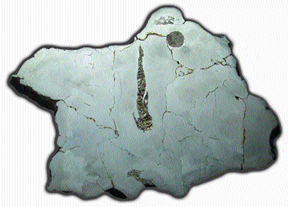 Impact events
and meteorite strikes are often associated with mass extinctions and widespread
devastation. But, despite this destructive reputation, impact events may have
played a role in the evolution of life, according to several new studies.
Impact events
and meteorite strikes are often associated with mass extinctions and widespread
devastation. But, despite this destructive reputation, impact events may have
played a role in the evolution of life, according to several new studies.A vein of the phosphorus-bearing mineral schreibersite cuts through this iron meteorite. Phosphorus from meteorites may have contributed to the origin of life in the early stages of Earth’s history. Image courtesy of Dante Lauretta and Matt Pasek.
In the so-called primordial soup experiments of the early 1950s, researchers produced the basic ingredients for life — amino acids and simple organic molecules — in the laboratory. In the 1960s, scientists discovered that certain types of meteorites contain amino acids and other fundamental organic compounds. The explanation of how amino acids evolve into complex proteins and eventually into living organisms, however, remains elusive.
One problem is producing RNA, a precursor to DNA that is capable of self-replication. The steps in creating RNA are unclear, but most of the necessary raw materials and elements are readily available at Earth’s surface — except phosphorus. Dante Lauretta and Matt Pasek at the University of Arizona say that meteorites could have provided the phosphorus needed to form complex biomolecules.
In a talk on Aug. 24 at the American Chemical Society’s national meeting in Philadelphia, Pa., Pasek presented research showing that iron meteorites, containing the rare phosphate mineral schreibersite, release their phosphorus in normal distilled water at room temperature. On early Earth, the high concentration of phosphorus surrounding these meteorites as they sat on the surface of Earth in pools of water may have contributed to the formation of complex molecules like RNA, Pasek says.
Other research by planetary geologist Ralph Lorenz, also at the University of Arizona, suggests that the conditions necessary for primitive biomolecules could be related to the meteorite strikes themselves in addition to any minerals they may have brought to the planet. In an upcoming issue of Icarus, Lorenz contends that asteroid impacts on Saturn’s largest moon, Titan, may have temporarily melted parts of its frozen surface — opening the door for early organic molecules.
“There is organic muck raining down from Titan’s atmosphere,” Lorenz says, “and if you add water, you very quickly begin producing amino acids.” Scientists are interested in Titan because its thick, hydrocarbon-rich atmosphere might be similar to Earth’s early atmosphere.
In Lorenz’s model, an impact melt resulting from a large meteorite could last more than 10,000 years. Smaller impact melts might last hundreds to thousands of years. “This happened throughout Titan’s history,” Lorenz says. “It presents a series of very interesting experiments in pre-biotic compounds.”
A similar scenario could play out on Earth, but Lorenz is hesitant to say meteorites really benefited early life. “Life may have started very early on Earth, but it was getting pounded by so many impacts that they may have hurt life or kept it from getting going,” he says. “There is no evidence that the net effect is positive.”

